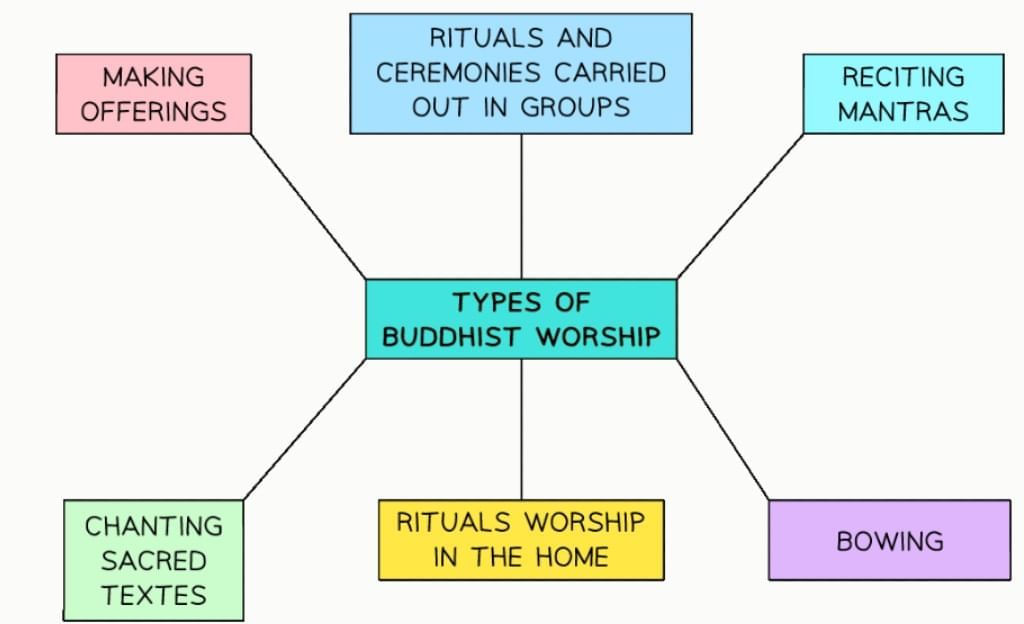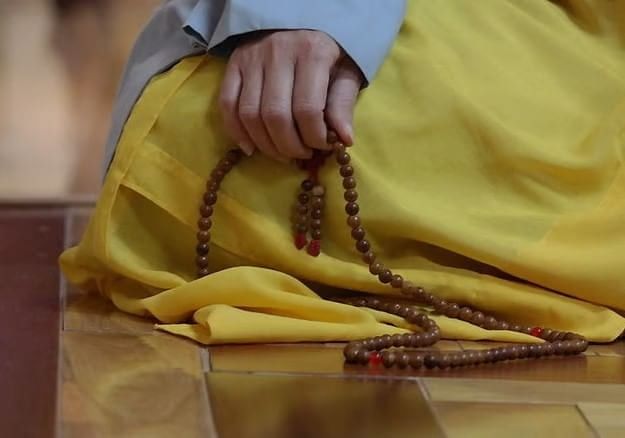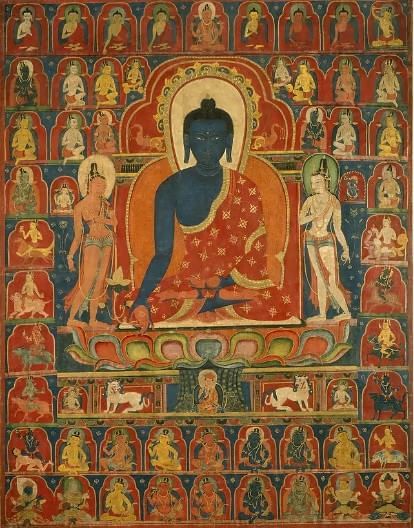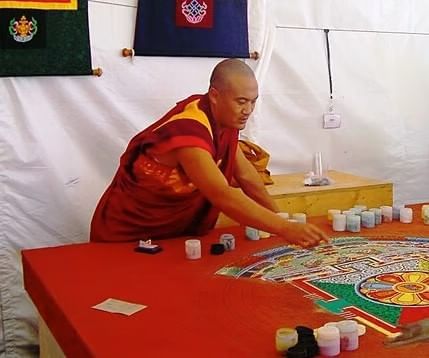Buddhism: Methods of Worship | Religion, Philosophy & Ethics for GCSE/IGCSE - Year 11 PDF Download
How Buddhists Worship (Puja)
The Purpose of Worship
Buddhist worship, known as puja, takes place both at home and in temples. It serves multiple purposes for Buddhists:
- It provides a way to show gratitude and reverence for the Buddha and his teachings.
- It fosters a closer connection to the Buddha and the values he represents.
- It deepens understanding of the Buddha’s teachings, referred to as the Dhamma.

Types of Buddhist Worship
Buddhist Chanting
Before the invention of printing or computers, Buddhist teachings were preserved and shared orally. This tradition gave rise to chanting, which monks used to memorize and transmit sacred texts. Today, chanting remains a key practice in Buddhism.
Buddhists recite holy texts to share the Buddha’s teachings, including:
- The Five Moral Precepts
- The Three Refuges
- The Bodhisattva vows
Chanting also serves to calm the mind, aiding concentration and facilitating a deeper understanding of the teachings.
Mantras
- A mantra consists of sacred syllables repeated multiple times, either aloud or silently in the mind. Mantras help focus the mind, making them a valuable tool for meditation. Some Buddhists believe mantras possess spiritual powers tied to the qualities of a Buddha or Bodhisattva.
- A well-known mantra among Tibetan Buddhists is om mani padme hum, which connects practitioners to Avalokiteshvara, the Bodhisattva of compassion. Chanting this mantra encourages the cultivation of compassion in daily life.
- To keep track of mantra recitations, which may number in the hundreds or thousands, Buddhists use a mala, a string of prayer beads. The mala is often carried throughout the day to support meditation and mindfulness in various settings.
Malal - String of prayer beads
Samatha (Concentration & Tranquility) Meditation
The Practice of Meditation
- Meditation is a central aspect of Buddhist worship, with many Buddhists meditating daily. Its primary goals are:
- Calming and stilling the mind.
- Gaining deeper insight into the Buddha’s teachings and the nature of existence.
- The Buddha described meditation’s value in the Dhammapada (v. 181): “Even the gods envy those awakened and mindful ones who are intent on meditation, wise, delighting in the peace of the absence of desire.”
- Buddhist meditation includes various techniques to develop samatha (calmness) and vipassana (insight). Practitioners may focus on objects or processes, such as breathing, to aid their meditation.
Samatha Meditation
- Samatha translates to “calming.”
- This form of meditation focuses on calming the mind and enhancing concentration, often through mindfulness of breathing.
Mindfulness of Breathing
- In samatha meditation, practitioners concentrate on their breath, noticing the sensations and bodily responses with each inhale and exhale.
- When distractions arise, they gently redirect their focus back to breathing.
Using Kasinas in Samatha Meditation
- A kasina is an object used to deepen concentration during meditation.
- The Buddha identified ten kasinas: earth, water, fire, wind, blue, yellow, red, white, space, and consciousness.
- To meditate with a kasina, a Buddhist places the object in front of them and focuses on it intently, using it as an alternative to breathing for concentration.

The Purpose of Samatha Meditation
- The goal of samatha meditation is to cultivate a calm and focused mind.
- In Theravada Buddhism, it is a foundational practice that prepares the practitioner for vipassana meditation.
Vipassana (Insight) Meditation
Vipassana Meditation
Also known as insight meditation, vipassana focuses on developing a deeper understanding of reality. It is the second primary meditation type in Theravada Buddhism and shares similarities with samatha, as both use mindfulness to enhance focus and concentration.
The Differences Between Samatha and Vipassana Meditation

The Aim of Vipassana Meditation
Vipassana meditation has three key objectives:
- Understanding the three marks of existence (impermanence, suffering, and non-self).
- Cultivating greater wisdom and insight.
- Ultimately achieving enlightenment.
Zazen Meditation
- Zazen, meaning “seated” in Japanese, is a form of meditation practiced in Zen Buddhism, a branch of Mahayana Buddhism.
- Practitioners sit, relax, and engage in mindful breathing, focusing on the present moment to deepen their understanding of existence, similar to the aims of vipassana.
Walking Meditation
- While meditation is often practiced seated, it can also be done while walking. In walking meditation, practitioners move slowly, synchronizing their steps with their breathing.
- This practice can be incorporated into both samatha and vipassana meditation.
The Visualisation of Buddhas & Bodhisattvas
What is Visualisation?
- Visualisation involves mentally imagining an object in detail.
- A practitioner may first observe an object, then set it aside and recreate its image in their mind.
- This mental image serves as a focal point for concentration and may embody specific spiritual qualities.
Deity Visualisation
- In Tibetan Buddhism, practitioners visualize enlightened beings, such as Buddhas or Bodhisattvas, during meditation.
- They focus on both the deity’s appearance and its spiritual attributes, sometimes imagining themselves as the deity to awaken their own Buddha-nature.
Examples of Buddhas or Bodhisattvas Used in Deity Visualisation
- The Medicine Buddha: Associated with healing, visualizing this Buddha is believed to reduce suffering and enhance healing abilities. A thangka of the Medicine Buddha, depicting a blue deity with red robes surrounded by smaller deities, is often used for this purpose.
- Avalokiteshvara: The Bodhisattva of compassion, visualization of whom helps practitioners cultivate compassion.
- Buddha Amitabha: Associated with rebirth in a paradise, Pure Land Buddhists visualize this Buddha to aid their aspiration for rebirth in the Pure Land.

Using Thangkas or Mandalas
Buddhists may use thangkas or mandalas to assist in deity visualization:
- A thangka is a detailed painting of a Buddha or Bodhisattva.
- A mandala is a complex, circular pattern symbolizing the Buddha, Buddhist teachings, or a pure land. In Tibetan monasteries, monks create mandalas from colored sand, which are later swept away to represent anicca (impermanence).

|
172 docs|3 tests
|
FAQs on Buddhism: Methods of Worship - Religion, Philosophy & Ethics for GCSE/IGCSE - Year 11
| 1. What is the significance of Puja in Buddhist worship? |  |
| 2. What are the main types of meditation practiced in Buddhism? |  |
| 3. How are Buddhas and Bodhisattvas visualized during meditation? |  |
| 4. What is the role of Thangkas and Mandalas in Buddhist worship? |  |
| 5. How does Buddhist worship vary among different traditions? |  |















